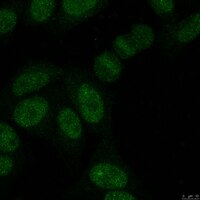MABS2039 Sigma-AldrichAnti-SUMO-2/3 Antibody, clone 8A2
Anti-SUMO-2/3, clone 8A2, Cat. No. MABS2039, is a mouse monoclonal antibody that detects SUMO-2 and SUMO-3 and has been tested for use in Immunocytochemistry, Immunoprecipitation, and Western Blotting.
More>> Anti-SUMO-2/3, clone 8A2, Cat. No. MABS2039, is a mouse monoclonal antibody that detects SUMO-2 and SUMO-3 and has been tested for use in Immunocytochemistry, Immunoprecipitation, and Western Blotting. Less<<Productos recomendados
Descripción
| Replacement Information |
|---|
Tabla espec. clave
| Species Reactivity | Key Applications | Host | Format | Antibody Type |
|---|---|---|---|---|
| H | ICC, IP, WB | M | Purified | Monoclonal Antibody |
| References |
|---|
| Product Information | |
|---|---|
| Format | Purified |
| Presentation | Purified mouse monoclonal antibody IgG2b in buffer containing 0.1 M Tris-Glycine (pH 7.4), 150 mM NaCl with 0.05% sodium azide. |
| Quality Level | MQ100 |
| Physicochemical Information |
|---|
| Dimensions |
|---|
| Materials Information |
|---|
| Toxicological Information |
|---|
| Safety Information according to GHS |
|---|
| Safety Information |
|---|
| Storage and Shipping Information | |
|---|---|
| Storage Conditions | Stable for 1 year at 2-8°C from date of receipt. |
| Packaging Information | |
|---|---|
| Material Size | 100 μg |
| Transport Information |
|---|
| Supplemental Information |
|---|
| Specifications |
|---|
| Global Trade Item Number | |
|---|---|
| Número de referencia | GTIN |
| MABS2039 | 04054839396618 |
Documentation
Anti-SUMO-2/3 Antibody, clone 8A2 Certificados de análisis
| Cargo | Número de lote |
|---|---|
| Anti-SUMO-2/3, clone 8A2 - 3422834 | 3422834 |
| Anti-SUMO-2/3, clone 8A2 - 4071293 | 4071293 |
| Anti-SUMO-2/3, clone 8A2 - 4145822 | 4145822 |
| Anti-SUMO-2/3, clone 8A2 - 4210450 | 4210450 |
| Anti-SUMO-2/3, clone 8A2 Monoclonal Antibody | Q2959736 |












 Antibody[208844-ALL].jpg)





